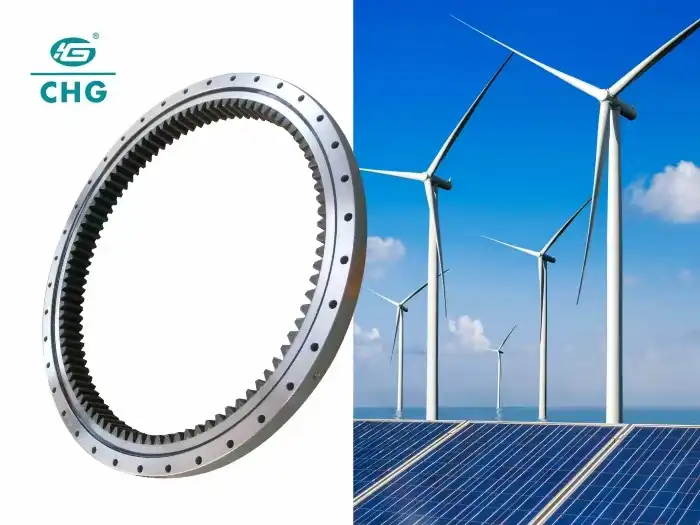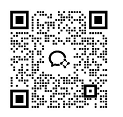Wind Turbine Slewing Bearing Applications in Yaw and Pitch Systems
Wind turbine slewing bearings play a crucial role in the efficient operation of modern wind energy systems, particularly in yaw and pitch control mechanisms. These specialized bearings are designed to support the massive loads and moments experienced by wind turbines while facilitating smooth rotational movement. In yaw systems, slewing bearings enable the nacelle to rotate horizontally, aligning the rotor with the wind direction for optimal energy capture. Similarly, in pitch systems, these bearings allow individual blade adjustment to regulate rotor speed and power output. The application of slewing bearings in wind turbines has significantly enhanced their performance, reliability, and lifespan. As the renewable energy sector continues to grow, the demand for high-quality, durable slewing bearings in wind turbine applications is expected to rise, driving innovations in bearing technology and manufacturing processes.
What are the key advantages of using slewing bearings in wind turbine yaw systems?
Enhanced Wind Capture Efficiency
Wind turbine slewing bearings in yaw systems significantly improve wind capture efficiency by allowing precise nacelle orientation. These bearings enable smooth rotation of the entire nacelle and rotor assembly, ensuring optimal alignment with the wind direction. The high load capacity and low friction characteristics of slewing bearings facilitate quick and accurate positioning, even under varying wind conditions. This responsiveness maximizes energy production by maintaining the turbine's optimal position relative to the wind. Additionally, the durability of wind turbine slewing bearings ensures consistent performance over extended periods, contributing to overall system reliability and reduced maintenance requirements.
Improved Structural Integrity
The use of wind turbine slewing bearings in yaw systems greatly enhances the structural integrity of wind turbines. These bearings are designed to withstand enormous axial and radial loads, as well as overturning moments generated by wind forces acting on the rotor and nacelle. By effectively distributing these loads, slewing bearings reduce stress on other components of the turbine structure, prolonging the lifespan of the entire system. The robust design of these bearings also helps in minimizing vibrations and absorbing shocks, further protecting the turbine from potential damage caused by extreme weather conditions or sudden wind gusts.
Enhanced Control and Safety Features
Wind turbine slewing bearings integrated into yaw systems offer enhanced control and safety features. These bearings often incorporate advanced sealing systems that protect against environmental contaminants, ensuring reliable operation in harsh conditions. Many modern slewing bearings used in wind turbines also feature integrated sensors for monitoring rotation angles, speeds, and loads. This data is crucial for implementing precise control strategies and early detection of potential issues. The ability to accurately control yaw positioning through these bearings also contributes to safety by allowing rapid shutdown or repositioning of the turbine in case of emergency situations or extreme weather events.

How do pitch system slewing bearings contribute to wind turbine efficiency?
Precise Blade Angle Adjustment
Wind turbine slewing bearings in pitch systems enable precise blade angle adjustments, which is crucial for optimizing turbine efficiency across various wind speeds. These bearings allow each blade to rotate independently around its longitudinal axis, changing its angle relative to the wind. This capability is essential for controlling rotor speed and power output. The high precision and low friction characteristics of slewing bearings ensure smooth and accurate blade movements, even under high loads. This level of control allows wind turbines to operate efficiently in a wider range of wind conditions, maximizing energy production while protecting the turbine from excessive loads during high wind speeds.
Load Mitigation and Turbine Longevity
Slewing bearings in pitch systems play a vital role in mitigating loads on the wind turbine structure, thereby enhancing turbine longevity. By allowing blades to adjust their pitch, these bearings help distribute aerodynamic loads more evenly across the rotor. This capability is particularly important during high wind events or sudden gusts, where the ability to quickly feather the blades can significantly reduce structural stress on the turbine. The robust design of wind turbine slewing bearings used in pitch systems ensures they can withstand the cyclic loads and moments associated with continuous blade adjustments, contributing to reduced maintenance needs and extended turbine operational life.
Energy Output Optimization
The application of wind turbine slewing bearings in pitch systems significantly contributes to energy output optimization. These bearings facilitate rapid and precise blade pitch adjustments, allowing the turbine to maintain optimal rotor speed and power output across varying wind conditions. During low wind speeds, the pitch can be adjusted to maximize energy capture, while at higher wind speeds, the pitch can be altered to limit rotor speed and power output to rated levels. This dynamic control, enabled by high-quality slewing bearings, ensures that the turbine operates at peak efficiency throughout its operational range, maximizing annual energy production and improving the overall cost-effectiveness of wind energy systems.

What are the maintenance considerations for wind turbine slewing bearings?
Regular Inspection and Lubrication
Proper maintenance of wind turbine slewing bearings is crucial for ensuring their longevity and optimal performance. Regular inspection is a key aspect of this maintenance regime. Technicians must periodically check for signs of wear, corrosion, or damage to the bearing surfaces and seals. The lubrication of these bearings is equally important. Wind turbine slewing bearings require specific types of lubricants that can withstand high loads and extreme temperatures. The lubrication schedule must be strictly adhered to, with the quantity and type of lubricant carefully controlled to prevent over-greasing or under-lubrication, both of which can lead to premature bearing failure. Advanced monitoring systems are often employed to track bearing condition and lubrication status, allowing for predictive maintenance strategies.
Alignment and Preload Adjustments
Maintaining proper alignment and preload is critical for the optimal functioning of wind turbine slewing bearings. Over time, the intense loads and environmental factors can cause slight misalignments or changes in preload conditions. Regular checks and adjustments are necessary to ensure that the bearing remains correctly aligned and that the preload is within specified limits. This process often involves specialized tools and expertise. Proper alignment and preload not only ensure efficient operation but also prevent uneven wear and excessive stress on bearing components. In some cases, advanced laser alignment techniques may be employed to achieve the high precision required for these large-scale bearings.
Condition Monitoring and Predictive Maintenance
Modern wind turbine slewing bearings often incorporate advanced condition monitoring systems. These systems use sensors to continuously monitor various parameters such as temperature, vibration, and rotational characteristics. The data collected is analyzed using sophisticated algorithms to detect early signs of potential issues. This approach enables predictive maintenance strategies, where maintenance actions are scheduled based on the actual condition of the bearing rather than fixed time intervals. Predictive maintenance helps prevent unexpected failures, reduces downtime, and optimizes maintenance costs. It also provides valuable insights into bearing performance under different operational conditions, contributing to ongoing improvements in bearing design and application.

Conclusion
Wind turbine slewing bearings are integral components in both yaw and pitch systems, significantly enhancing the efficiency, reliability, and longevity of wind turbines. Their application in these systems enables precise control of turbine orientation and blade angles, optimizing energy capture across various wind conditions. As the wind energy sector continues to grow, the importance of high-quality slewing bearings in ensuring turbine performance and durability cannot be overstated. Ongoing advancements in bearing technology, coupled with effective maintenance strategies, will continue to play a crucial role in the evolution of wind energy systems, contributing to a more sustainable and efficient renewable energy future.
For more information on high-quality wind turbine slewing bearings and other bearing solutions, please contact CHG at sale@chg-bearing.com. With our extensive experience and commitment to innovation, we are well-equipped to meet your specific bearing needs in the wind energy sector and beyond.
References
1. Johnson, K. E., & Fleming, P. A. (2011). Development and implementation of control-oriented models for wind turbines. Mechatronics, 21(4), 728-736.
2. Bak, C., Zahle, F., Bitsche, R., Kim, T., Yde, A., Henriksen, L. C., ... & Natarajan, A. (2013). Description of the DTU 10 MW reference wind turbine. DTU Wind Energy Report-I-0092, 5, 1-138.
3. Ragheb, A., & Ragheb, M. (2011). Wind turbine gearbox technologies. In Fundamental and Advanced Topics in Wind Power. IntechOpen.
4. Harris, T. A., & Kotzalas, M. N. (2006). Essential concepts of bearing technology. CRC press.
5. Burton, T., Jenkins, N., Sharpe, D., & Bossanyi, E. (2011). Wind energy handbook. John Wiley & Sons.
6. Hau, E. (2013). Wind turbines: fundamentals, technologies, application, economics. Springer Science & Business Media.

